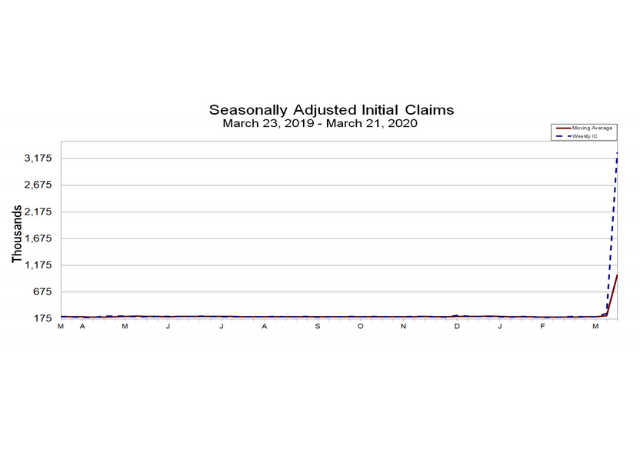Coronavirus’ Other Toll: 3.2 Million Americans Filed for Unemployment Last Week

Thursday morning the Department of Labor released their report outlining weekly unemployment claims. For the week ending March 21, unemployment claims skyrocketed, topping 3.2 million nationally, a direct result of the national economic shutdown meant to slow the spread of Coronavirus.
From the DOL:
In the week ending March 21, the advance figure for seasonally adjusted initial claims was 3,283,000, an increase of 3,001,000 from the previous week’s revised level. This marks the highest level of seasonally adjusted initial claims in the history of the seasonally adjusted series. The previous high was 695,000 in October of 1982. The previous week’s level was revised up by 1,000 from 281,000 to 282,000. The 4-week moving average was 998,250, an increase of 765,750 from the previous week’s revised average. The previous week’s average was revised up by 250 from 232,250 to 232,500.The advance seasonally adjusted insured unemployment rate was 1.2 percent for the week ending March 14, unchanged from the previous week’s unrevised rate. The advance number for seasonally adjusted insured unemployment during the week ending March 14 was 1,803,000, an increase of 101,000 from the previous week’s revised level. This is the highest level for insured unemployment since April 14, 2018 when it was 1,824,000. The previous week’s level was revised up 1,000 from 1,701,000 to 1,702,000. The 4-week moving average was 1,731,000, an increase of 27,500 from the previous week’s revised average. The previous week’s average was revised up by 250 from 1,703,250 to 1,703,500.
And this is only the beginning.
MarketWatch has more:
The seasonally adjusted increase in initial jobless claims from March 15 to March 21 was the largest ever, easily crushing the previous record rise of 695,000 in October 1982. The tally in the prior week was 282,000.
The sudden surge in claims is likely just the beginning. Waves of fresh layoffs are expected with many states ordering nonessential businesses to close.Wall Street was bracing for a terrible number. Economists polled by MarketWatch had forecast a 2.5 million increase. Just a few weeks ago, new clams hovered near a 50-year low….The flood of Americans applying for unemployment benefits was heaviest in states suffering the most from the coronavirus, but they soared everywhere. The biggest increase was in Pennsylvania, followed by Ohio, New Jersey, Massachusetts and California.The extent of the layoffs, if anything, was understated by the latest claims report.Many Americans were unable to file claims because some state computer systems got overloaded. And some workers classified as independent contractors, such as Uber drivers, weren’t eligible to apply for benefits, though the new congressional bailout package will soon offer some a chance to collect unemployment checks.A deluge of additional layoffs are still coming. Americans who work at airlines, retailers, restaurants, hotels, theaters and travel agencies are particularly vulnerable. Small businesses with limited financial resources are also hurting.
The markets don’t appear too concerned about the spike in unemployment, likely because the Senate unanimously passed an economic stimulus relief package late last night.
From the NYT:
Stocks rose for the third straight day on Thursday, as investors looked past a startling rise in applications for unemployment benefits and bid up the shares of companies set to receive support from the $2 trillion coronavirus aid bill recently approved by the Senate.
The S&P 500 was up more than 4 percent, while the Dow Jones industrial average rose even further, lifted by a 15-percent surge in Boeing’s share price.
Stocks have been rallying since Tuesday, when the S&P 500 had its best day since October 2008 with a 9.4 percent climb, as investors anticipated Washington’s support for a number of industries.
Earlier in the week, Trump indicated he hoped to have the country back up and running by Easter, which seems overly ambitious. That said, I’d be willing to bet that he knows mid-April is a stretch, but the public (and the markets) need to know that someone is looking ahead to an end of the shutdown. It’s better to say mid-April and then extend that by two weeks than to say 5 weeks, which seems like an eternity at this juncture.
CLICK HERE FOR FULL VERSION OF THIS STORY